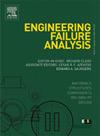Analysis of typical cases of corrosion failure of tubing in heavy oil fire-flooding production wells
IF 4.4
2区 工程技术
Q1 ENGINEERING, MECHANICAL
引用次数: 0
Abstract
A corrosion failure of tubing often occurs during the production process of production wells in heavy oil fire-flooding blocks and thus affects service safety. In the study, the service information of tubings in fire-flooding blocks was analyzed and the physical and chemical properties of defunct tubings were determined. In addition, the causes for the failures of series tubings with wall thickness thinning and corrosion perforation were revealed by SEM, EDS, and XPS. The common corrosion types of tubings and the inducing factors of different failure forms were clarified and corresponding anti-corrosion suggestions were given. The material of defunct tubings was not the failure cause. When high-temperature gas channeling and unburned O2 occurred, corrosion was intensified by a high content of Cl−, thus resulting in the corrosion failure of series tubings with serious wall thickness thinning. When a high content of Ca2 + existed in formation water, a CaCO3 scale layer was formed to adhere to the outer wall of the tubing and aggravate local corrosion under the action of a high content of Cl−. This above process was the cause for corrosion perforation. CO2/H2S corrosion generally occurred in the tubings of fire-flooding production wells. The inducing factors of tubing failures included high-temperature gas channeling, unburned O2, a high content of Ca2 +, and a high content of Cl−. It is recommended to use imidazoline corrosion inhibitor XCN-ZO2 and annular outer wall aluminum-based sacrificial anode anti-corrosion short sections for corrosion protection.
求助全文
约1分钟内获得全文
求助全文
来源期刊

Engineering Failure Analysis
工程技术-材料科学:表征与测试
CiteScore
7.70
自引率
20.00%
发文量
956
审稿时长
47 days
期刊介绍:
Engineering Failure Analysis publishes research papers describing the analysis of engineering failures and related studies.
Papers relating to the structure, properties and behaviour of engineering materials are encouraged, particularly those which also involve the detailed application of materials parameters to problems in engineering structures, components and design. In addition to the area of materials engineering, the interacting fields of mechanical, manufacturing, aeronautical, civil, chemical, corrosion and design engineering are considered relevant. Activity should be directed at analysing engineering failures and carrying out research to help reduce the incidences of failures and to extend the operating horizons of engineering materials.
Emphasis is placed on the mechanical properties of materials and their behaviour when influenced by structure, process and environment. Metallic, polymeric, ceramic and natural materials are all included and the application of these materials to real engineering situations should be emphasised. The use of a case-study based approach is also encouraged.
Engineering Failure Analysis provides essential reference material and critical feedback into the design process thereby contributing to the prevention of engineering failures in the future. All submissions will be subject to peer review from leading experts in the field.
 求助内容:
求助内容: 应助结果提醒方式:
应助结果提醒方式:


